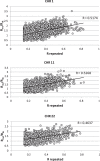Contribution of Heritability and Epigenetic Factors to Skeletal Muscle Mass Variation in United Kingdom Twins
- PMID: 27144936
- PMCID: PMC4891794
- DOI: 10.1210/jc.2016-1219
Contribution of Heritability and Epigenetic Factors to Skeletal Muscle Mass Variation in United Kingdom Twins
Abstract
Context: Skeletal muscle mass (SMM) is one of the major components of human body composition, with deviations from normal values often leading to sarcopenia.
Objective: Our major aim was to conduct a genome-wide DNA methylation study in an attempt to identify potential genomic regions associated with SMM.
Design: This was a mixed cross-sectional and longitudinal study.
Setting: Community-based study.
Participants: A total of 1550 middle-aged United Kingdom twins (monozygotic [MZ] and dizygotic [DZ]), 297 of which were repeatedly measured participated in the study.
Main outcome measure: Appendicular lean mass assessed using dual-energy X-ray absorptiometry technology, and methylated DNA immunoprecipitation sequencing DNA methylation profiling genome-wide were obtained from each individual.
Results: Heritability estimate of SMM, with simultaneous adjustment for covariates obtained using variance decomposition analysis, was h(2) = 0.809 ± 0.050. After quality control and analysis of longitudinal stability, the DNA methylation data comprised of 723 029 genomic sites, with positive correlations between repeated measurements (Rrepeated = 0.114-0.905). Correlations between MZ and DZ twins were 0.51 and 0.38 at a genome-wide average, respectively, and clearly increased with Rrepeated. Testing for DNA methylation association with SMM in 50 discordant MZ twins revealed 36 081 nominally significant results, of which the top-ranked 134 signals (P < .01 and Rrepeated > 0.40) were subjected to replication in the sample of 1196 individuals. Seven SMM methylation association signals replicated at a false discovery rate less than 0.1, and these were located in or near genes DNAH12, CAND1, CYP4F29P, and ZFP64, which have previously been highlighted in muscle-related studies. Adjusting for age, smoking, and blood cell heterogeneity did not alter significance of these associations.
Conclusion: This epigenome-wide study, testing longitudinally stable methylation sites, discovered and replicated a number of associations between DNA methylation at CpG loci and SMM. Four replicated signals were related to genes with potential muscle functions, suggesting that the methylome of whole blood may be informative of SMM variation.
Figures


Similar articles
-
Neonatal DNA methylation profile in human twins is specified by a complex interplay between intrauterine environmental and genetic factors, subject to tissue-specific influence.Genome Res. 2012 Aug;22(8):1395-406. doi: 10.1101/gr.136598.111. Epub 2012 Jul 16. Genome Res. 2012. PMID: 22800725 Free PMC article.
-
Impact of the genome on the epigenome is manifested in DNA methylation patterns of imprinted regions in monozygotic and dizygotic twins.PLoS One. 2011;6(10):e25590. doi: 10.1371/journal.pone.0025590. Epub 2011 Oct 3. PLoS One. 2011. PMID: 21991322 Free PMC article.
-
Characterizing genetic and environmental influences on variable DNA methylation using monozygotic and dizygotic twins.PLoS Genet. 2018 Aug 9;14(8):e1007544. doi: 10.1371/journal.pgen.1007544. eCollection 2018 Aug. PLoS Genet. 2018. PMID: 30091980 Free PMC article.
-
Integrative DNA methylome analysis of pan-cancer biomarkers in cancer discordant monozygotic twin-pairs.Clin Epigenetics. 2016 Jan 20;8:7. doi: 10.1186/s13148-016-0172-y. eCollection 2016. Clin Epigenetics. 2016. PMID: 26798410 Free PMC article.
-
Research progress of regulatory mechanism of DNA methylation in complex traits using monozygotic twins.Yi Chuan. 2016 Dec 20;38(12):1043-1055. doi: 10.16288/j.yczz.16-238. Yi Chuan. 2016. PMID: 28034837 Review.
Cited by
-
The heritability of body composition.BMC Pediatr. 2021 May 8;21(1):225. doi: 10.1186/s12887-021-02695-z. BMC Pediatr. 2021. PMID: 33964919 Free PMC article.
-
Capturing functional epigenomes for insight into metabolic diseases.Mol Metab. 2020 Aug;38:100936. doi: 10.1016/j.molmet.2019.12.016. Epub 2020 Feb 14. Mol Metab. 2020. PMID: 32199819 Free PMC article. Review.
-
Developmental Programming of Body Composition: Update on Evidence and Mechanisms.Curr Diab Rep. 2019 Jul 20;19(8):60. doi: 10.1007/s11892-019-1170-1. Curr Diab Rep. 2019. PMID: 31327060 Review.
-
BDNF coexpresses with MTOR and is associated with muscle fiber size, lean mass and power-related traits.Eur J Appl Physiol. 2025 Apr 29. doi: 10.1007/s00421-025-05804-3. Online ahead of print. Eur J Appl Physiol. 2025. PMID: 40299026
-
Genome-wide methylation analysis of a large population sample shows neurological pathways involvement in chronic widespread musculoskeletal pain.Pain. 2017 Jun;158(6):1053-1062. doi: 10.1097/j.pain.0000000000000880. Pain. 2017. PMID: 28221285 Free PMC article.
References
-
- Chen Z, Wang Z, Lohman T, et al. Dual-energy x-ray absorptiometry is a valid tool for assessing skeletal muscle mass in older women. J Nutr. 2007;137:2775–2780. - PubMed
-
- Doherty TJ. Invited review: aging and sarcopenia. J Appl Physiol. 2003;95:1717–1727. - PubMed
-
- Kalinkovich A, Livshits G. Sarcopenia–The search for emerging biomarkers. Ageing Res Rev. 2015;22:58–71. - PubMed
-
- Karakelides H, Nair KS. Sarcopenia of aging and its metabolic impact. Curr Top Dev Biol. 2005;68:123–148. - PubMed
-
- Arden NK, Spector TD. Genetic influences on muscle strength, lean body mass, and bone mineral density: a twin study. J Bone Miner Res. 1997;12:2076–2081. - PubMed
Publication types
MeSH terms
Substances
Grants and funding
LinkOut - more resources
Full Text Sources
Other Literature Sources

